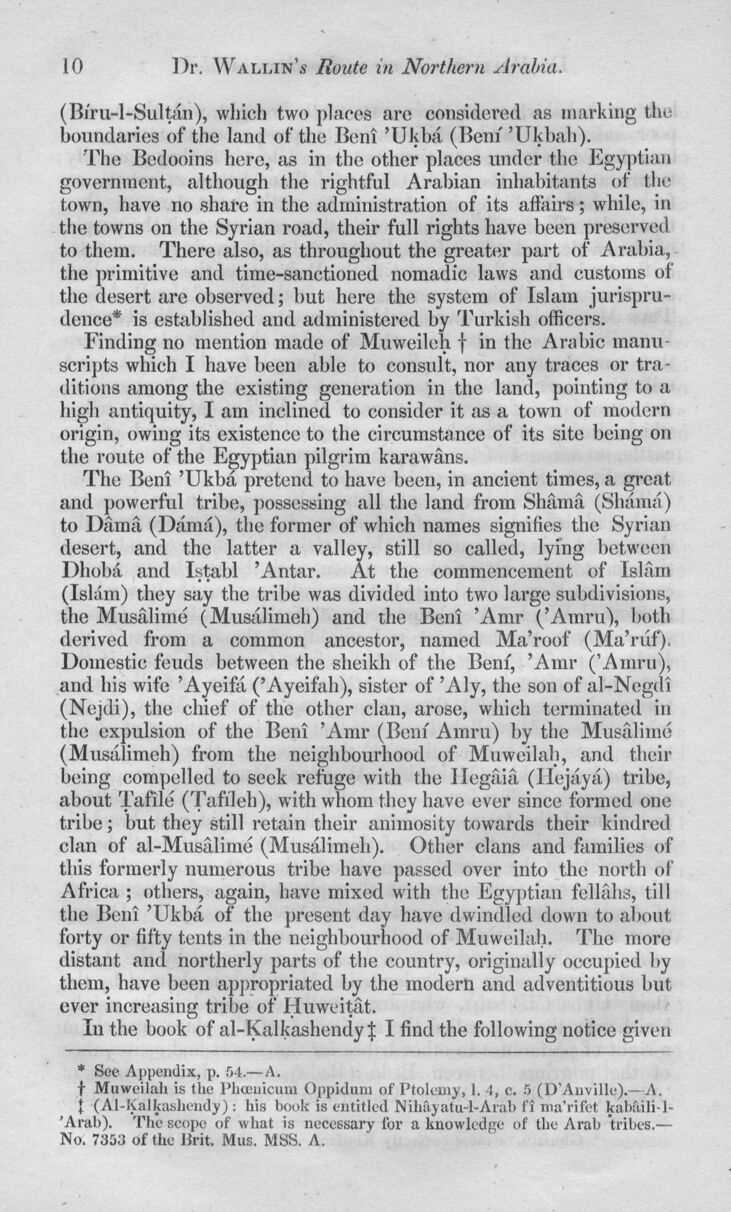
Full resolution (JPEG) - On this page / på denna sida - Route in Northern Arabia

<< prev. page << föreg. sida << >> nästa sida >> next page >>
Below is the raw OCR text
from the above scanned image.
Do you see an error? Proofread the page now!
Här nedan syns maskintolkade texten från faksimilbilden ovan.
Ser du något fel? Korrekturläs sidan nu!
This page has never been proofread. / Denna sida har aldrig korrekturlästs.
[-(Bi’ru-l-Sultan),-]{+10
Dr. Wallin’s Route in Northern Arabia.
(Bi’ru-l-Sultan),+} which two places are considered as marking the
boundaries of the land of the Beni ’Ukba (Beni’ ’Ukbali).
The Bedooins here, as in the other places under the Egyptian
government, although the rightful Arabian inhabitants of the
town, have no share in the administration of its affairs; while, in
the towns on the Syrian road, their full rights have been preserved
to them. There also, as throughout the greater part of Arabia,
the primitive and time-sanctioned nomadic laws and customs of
the desert are observed; but here the system of Islam
jurisprudence* is established and administered by Turkish officers.
Finding no mention made of Muweileh f in the Arabic
manuscripts which I have been able to consult, nor any traces or
traditions among the existing generation in the land, pointing to a
high antiquity, I am inclined to consider it as a town of modern
origin, owing its existence to the circumstance of its site being on
the route of the Egyptian pilgrim karawans.
The Beni ’Ukba pretend to have been, in ancient times, a great
and powerful tribe, possessing all the land from Shama (Sluima)
to Dama (Damd), the former of which names signifies the Syrian
desert, and the latter a valley, still so called, lying between
Dhobi and Istabl ’Antar. At the commencement of Islam
(Islam) they say the tribe was divided into two large subdivisions,
the Musalime (Musalimeh) and the Beni ’Amr (’Amru), both
derived from a common ancestor, named Ma’roof (Ma’riif).
Domestic feuds between the sheikh of the Beni, ’Ann- (’Amru),
and his wife ’Ayeifa (’Ayeifah), sister of ’Aly, the son of al-Negdi
(Nejdi), the chief of the other clan, arose, which terminated in
the expulsion of the Beni ’Amr (Beni Amru) by the Musfilime
(Musalimeh) from the neighbourhood of Muwcilah, and their
being compelled to seek refuge with (be Ilegaia (liejaya) tribe,
about Tafile (Tafileh), with whom they have ever since formed one
tribe; but they still retain their animosity towards their kindred
clan of al-Musalime (Musalimeli). Other clans and families of
this formerly numerous tribe have passed over into the north of
Africa; others, again, have mixed with the Egyptian fellahs, till
the Beni ’Ukba of the present day have dwindled down to about
forty or fifty tents in the neighbourhood of Muwcilah. The more
distant anil northerly parts of the country, originally occupied by
them, have been appropriated by the modern and adventitious but
over increasing tribe of Huweitat.
In the book of al-Kalkashendy | I find the following notice given
* See Appendix, p. 54.— A.
t Muweilali is the Plitnuicmu Oppidum of Ptolemy, I. 4, c. 5 (D’Anville).—A.
( (Al-Kalknslicudy): his hook is entitled Nihfiyiitu-l-Aral) I S ma’rifet
kahfUIi-1-’Arab). The scope of what is necessary for a knowledge of the Arab ’tribes.—
No. 7353 of (he Brit. Mus. MSS. A.
<< prev. page << föreg. sida << >> nästa sida >> next page >>